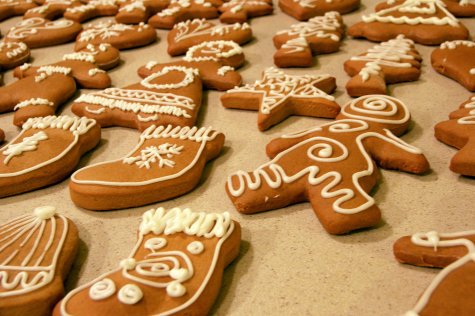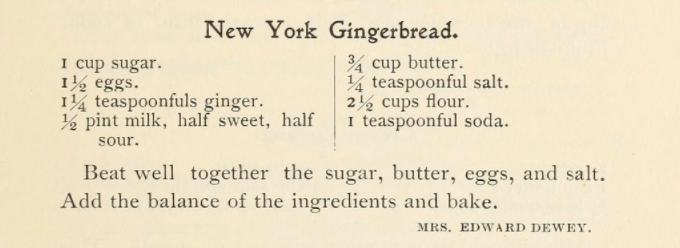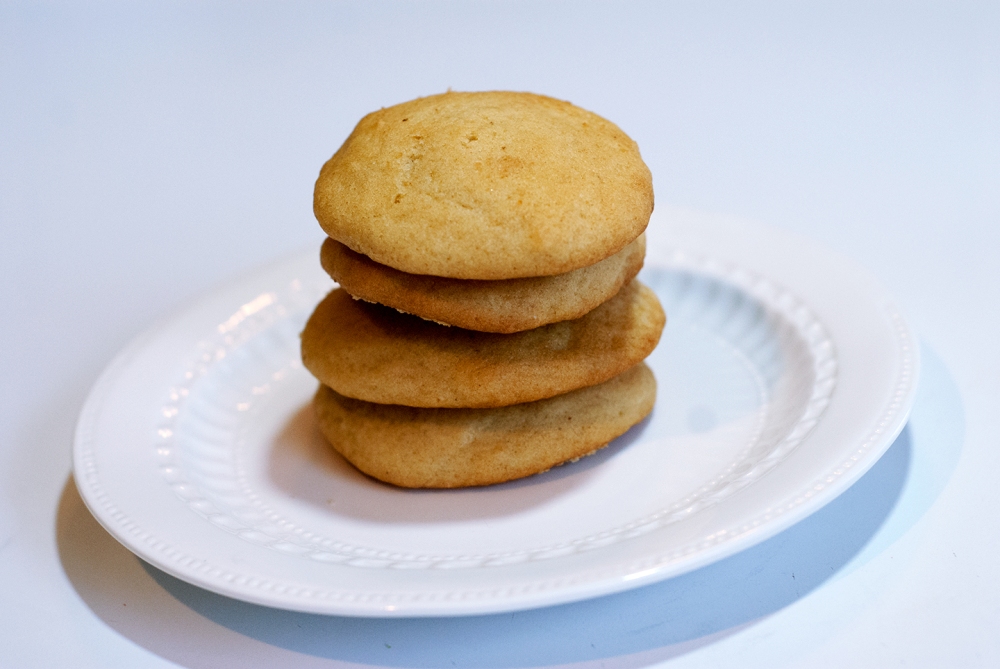Today’s recipe is an interesting 19th century take on a classic: Gingerbread. Unlike most traditional gingerbread that is dense, dark, and heavy on ginger, this “New York” Gingerbread is soft and fluffy and has subtler flavors.

When we think of gingerbread we tend to imagine little crunchy cookies shaped into little men for the Christmas season. 16th century Germans discovered that sheets of these hard cookies make ideal walls for gingerbread houses. Believe it or not “gingerbread” has been around for centuries, though not always in a form we would recognize today. The oldest known recipe for bread or cake spiced with ginger comes from ancient Greece around 2400 BC! Chinese recipes for gingerbread showed up around the 10th century and later spread to Europe where “preserved ginger” became hugely popular during the Middle Ages. Elizabethans were especially fond of gingerbread biscuits shaped into animals and human figures, which were often associated with wealth and elegance. Later, English colonists brought gingerbread to the American colonies where softer varieties became the preference. Over the years advances in technology and the wider availability of commercially-refined ingredients changed the way foods, particularly baked goods, were made.
Three major food innovations are responsible for the evolution of traditional hard gingerbread cookies into the soft, raised cookies featured in the recipe below:
Wheat
Prior to the mid-19th century, wheat flour was not as common in American food as it is today. Over time, milling techniques improved and new, hardier types of wheat were being grown in the U.S. and Canada. Coupled with cheaper and faster transportation, commercially refined wheat was finally available to the public in large amounts. The price went down and wheat flour quickly became the flour of choice.
Sugar
Sugar had been available and widespread for a very long time, but it wasn’t until the end of the 19th century that granulated refined white “table” sugar was the norm, even a necessity, in American cooking. Before then baked goods were sweetened with brown sugar and molasses, two core ingredients in a traditional gingerbread recipe. Sugar was still relatively expensive, and if a housewife wanted to use loaf sugar she would have to grind it herself. Granulated sugar was not only more convenient, but also easier to use in baking. Finer crystals are dissolved quicker and affect the appearance, texture and taste of baked goods.
Leavening Chemicals
To change a flat, dense cake into a light and fluffy one you need a leavening agent. Without something in the batter that essentially adds gas bubbles and softens the final product, a baker would need to use other methods like vigorously whipping eggs (this can be exhausting when done by hand) or kneading dough for very long periods of time. Yeast is an agent that leavens through fermentation, which is fine for bread but is neither especially desirable in cakes, nor easy to do.
During the 1830’s, sodium bicarbonate (baking soda) was combined with sour milk and used as a leavening agent in breads. Cream of tartar replaced potash (a common chemical leavening agent in the 18th century) and was often used to help the soda activate rather than rely on the unpredictable acidity of sour milk. Since soda and cream of tartar were best used together for most baking goods, they were combined into a commercial baking powder in the 1840’s. The two products tended to react prematurely when packaged together so in 1869 a chemist named Eben Norton Horsford came up with a solution by adding corn starch to the mix to keep it moisture resistant. Baking powder as we know it was born! This invention was revolutionary for home cooks everywhere and suddenly a new world of baking opened up, introducing a much wider variety of cakes, cookies and other baked goods.
The Recipe
This recipe for New York Gingerbread comes from a cookbook called The Dewey Cook Book, created by a Montpelier, Vermont YMCA women’s auxiliary group. A little bit of internet sleuthing led me to some interesting history connecting the name Dewey to Montpelier in 1899, the year this recipe book was printed.
On October 12th of 1899, residents of Vermont put together an enormous celebration welcoming Admiral George Dewey, the naval war hero, back to his home town of Montpelier. George Dewey was nationally recognized for leading the destruction of the Spanish fleet in the Philippines during the Spanish American War. “Dewey Day,” as it was called, featured fireworks, a parade, ovations and other special festivities for thousands of attendees. I suspect this cookbook was written and published specifically for the event to be handed out to a handful of special guests or perhaps even sold as a souvenir.
The recipe was submitted to the Ladies Auxiliary by Mrs. Edward Dewey herself. Could this be the wife of George Dewey’s brother Edward?
New York Gingerbread

Ingredients
- 1 c. sugar
- 1 large egg
- 1 1/4 tsp. ginger
- 1/2 c. whole milk
- 1/2 c. buttermilk
- 3/4 c. butter
- 1/4 tsp. salt
- 2 1/2 c. flour
- 1 tsp. baking soda

For Cookies:
In a large bowl, cream together the butter and sugar. Beat in the egg and salt. Combine milks together and add to the bowl, mixing well. Instead of sour milk we are using buttermilk, which is a type of soured milk. While buttermilk is not exactly the same thing as “sour” milk, the two can be used interchangeably. “Sweet” milk is just a dated reference to milk that isn’t buttermilk.
Tip: Do NOT use spoiled milk as sour milk. They are not the same thing.
Next, sift your flour and combine dry ingredients together. Scoop by the tablespoon onto a prepared cookie sheet and bake at 350 degrees for around 12-13 minutes or until toothpick comes out clean. Your batter will be sticky so you may need to use an additional spoon to scoop it out. Yields around 40-45 cookies.
Tip: You do not have to sift your flour but I recommend doing so. Sifting flour isn’t as necessary today as it was back in 1899, but it still results in a fluffier texture. For even better results, sift all the dry ingredients together.
For a cake:
This recipe was found in the cookie section of the book but can easily be adapted to make a wonderful gingerbread cake. Make batter same as above then simply pour it into a standard cake pan, or even a 9X9 dish and bake at 350 degrees for 1 hour.
New York Gingerbread is very easy to make and I genuinely enjoyed both the cookies and the cake. The cookies reminded me a lot of Nilla wafer cookies, but with a hint of ginger. Frost them if you’d like, but I think they’re just fine as is. Not only are they a tasty little treat for the holidays (or really any day), but they are a perfect representation of the technological advances of 19th-century American baking.
If you enjoyed this recipe, check out this 1893 recipe for Minnehaha Cake.

Sources:
- American Chemical Society National Historic Chemical Landmarks. Development of Baking Powder. Accessed November 10, 2017.
- Avey, Tori. The History of Gingerbread. PBS Food: The History Kitchen, Dec 20, 2013. Accessed November 10, 2017.
- Difference Between Sugar and Molasses. Difference Between. http://www.differencebetween.info. Accessed November 10, 2017.
- Hoffman, Regan. How the Victorian Obsession with Sugar Created the Humble Sugar Cube. Saveur Magazine, Feb 22, 2017. Accessed November 10, 2017.
- Levene, Alysa. Cake: A Slice of History. New York: Pegasus Books Ltd, 2016. Print.
- Snell, Rachel A. Having Their Cake: Ingredients and Recipe Collecting in the Nineteenth Century. The Recipes Project, June 11, 2014. Accessed November, 2017.
- Woodsmoke Productions and Vermont Historical Society, “Dewey Day: A century Ends,” The Green Mountain Chronicles radio broadcast and background information, original broadcast 1988-89, accessed on the web at http://vermonthistory.org/research/research-resources-online/green-mountain-chronicles/dewey-day-a-century-ends-1899-1900.



Nice recipe
LikeLiked by 1 person
What a great recipe. The ingredients are simple and easy to keep on hand. That is what I like about these really old recipes. Thanks for sharing this recipe plus the story behind it;
LikeLiked by 1 person
Thanks for sharing the history and recipe. This is the kind go gingerbread cookie I like.
LikeLiked by 1 person